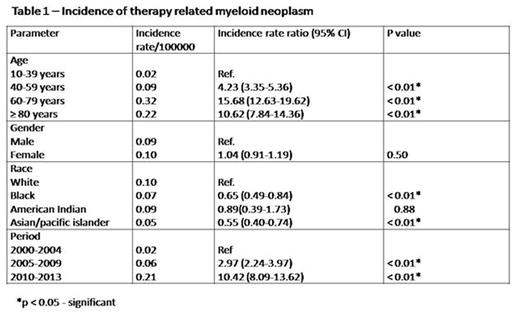Abstract
Background:
Therapy related myeloid neoplasm (t-MN) such as acute myeloid leukemia and myelodysplasia are emerging challenges in the current era when newer therapies are improving patient survival in many malignancies. Although clinical trials have reported the outcomes of t-MN, the real world data on its incidence and overall survival (OS) at population level remains sparse.
Methods:
Using Surveillance Epidemiology and End Results (SEER-18) database, we identified patients aged ≥ 10 years with pathologically confirmed t-MN (ICD-0-3 code 9920) diagnosed between the years 2000-2013 and actively followed. Incidence rate per 100000 population and incidence rate ratio (IRR) were calculated to describe the relative differences in disease incidence between the subgroups. Race was divided as Whites, Blacks, American Indians and Asian/pacific islanders. Three year OS was calculated by Kaplan-Meier method and compared by log rank test. Determinants of OS were analyzed with Cox proportional hazard regression method. Statistical analyses were done with significance level of p < 0.05.
Results:
A total of 941 patients with t-MN who met the study criteria were identified. Median age of the cohort was 63 years (10-85 years). Majority of the patients had age ≥60 years (58.2%), females (55.2%) and White race (86.4%). Overall incidence of t-MN was 0.09 cases/100000 population and showed significant variations with age, race and the period of diagnosis (Table 1). The disease incidence increased significantly after the age 40 (IRR ranging from 4.23 to 15.68, p < 0.01) and after the year 2005 (IRR ranging from 2.97 to 10.42, p < 0.01). Compared to White race, Blacks (IRR 0.65, p < 0.01) and Asian/pacific islanders (IRR 0.55, p < 0.01) had a significantly lower disease incidence. The 3-year OS significantly declined with increasing age (41.8% in age group 10-39, 27.3% in age group 41-59, 11.9% in age group 61-79 and 8.0% in age ≥ 80, p < 0.01). However, 3-year OS did not significantly vary by gender (19.3% in females vs. 20.7% in males, p = 0.92) or race (Whites 19.9%, Blacks 10.6%, American Indians 26.7%, Asian/pacific islander 30.7%, p = 0.43). There was an improvement in the 3-year OS over period (year 2000-2004- 13.4% vs. year 2005-2009 -17.1% vs. year 2010-2013 - 20.6%, p < 0.01). On multivariate analysis, increasing age was associated with significantly higher risk of mortality (age 40-59 - HR 1.46, CI 1.07 - 2.00, p = 0.01; age 60-79 - HR 2.32, CI 1.72 - 3.14, p < 0.01; age ≥80 - HR 3.81, CI 2.63 - 5.50, p < 0.01). Compared to the period 2000-2004, a significantly lower risk for mortality was seen in the period 2010-2013 (HR 0.55, CI 0.42-0.74, p < 0.01).
Conclusions:
The incidence of t-MN has significantly increased in the last decade and varies with factors such as age and race. Although OS has improved in the period 2010-2013, outcomes of this disorder continue to remain poor at the population level. Further research to identify the disease risk factors and development novel therapies is required to improve the outcomes.
Michaelis:Pfizer: Equity Ownership; Cellgene Corporation: Consultancy, Honoraria, Membership on an entity's Board of Directors or advisory committees, Speakers Bureau; Incyte Corporation: Consultancy, Honoraria. Atallah:Pfizer: Other: Grant review; Takeda: Research Funding; Novartis: Consultancy; BMS: Consultancy; CTI biopharma: Consultancy; Incyte: Consultancy; Ariad: Honoraria.
Author notes
Asterisk with author names denotes non-ASH members.


This feature is available to Subscribers Only
Sign In or Create an Account Close Modal